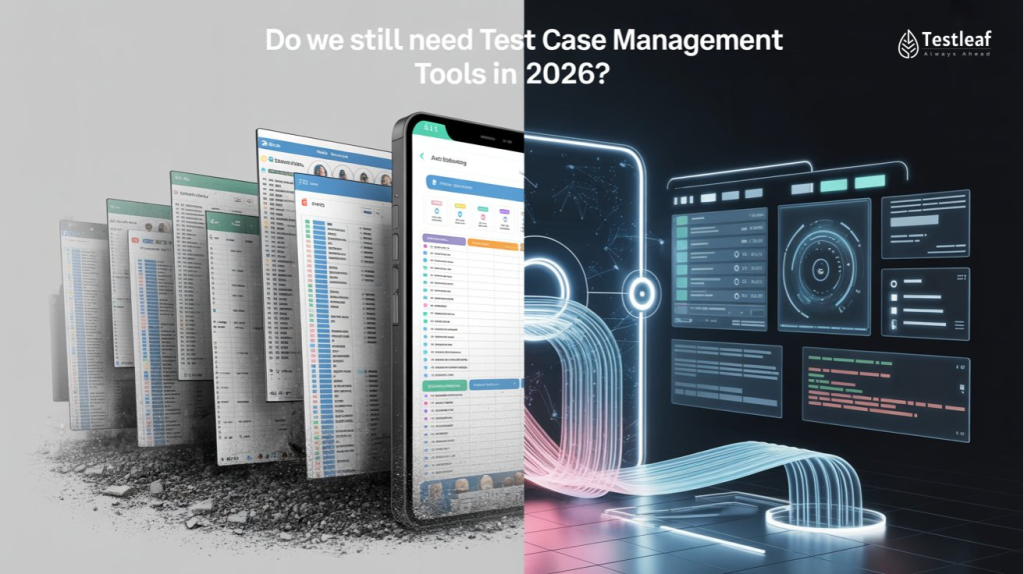If you’ve been in the QA world for a while, you’ve probably wondered: Do we still need test case management tools in 2026? Because honestly, every time we log into one, it feels like revisiting an old relic — clean, structured, but frozen in time.
Back in the day, Test Case Management (TCM) tools were the foundation of software testing. They gave us structure, traceability, and a sense of control. Every test case had an ID, every step was documented, and every run was logged. But as software delivery has evolved with CI/CD, agile, and AI-driven automation, those very tools now feel like they belong to a slower, documentation-heavy era.
Today’s testers work in a completely different rhythm — fast, collaborative, and code-driven. And that’s why many are starting to ask whether traditional TCM tools still make sense in a world where testing happens continuously and context matters more than checkboxes.
The Testing Landscape Has Changed — Radically
Developers have moved their documentation inside code. Product managers live inside live backlogs. Designers work in collaborative tools like Figma. Meanwhile, testers? Many of us are still toggling between Jira, Excel sheets, and clunky TCM tools — trying to keep everything “in sync.”
That’s where the tests-as-code movement has brought a refreshing shift. Instead of writing static, human-readable descriptions of test cases, testers are defining them as executable, version-controlled scripts that evolve alongside the application code.
It’s clean. It’s automated. It’s living documentation.
✅ No duplicate effort.
✅ No broken integrations.
✅ No confusion about “who owns this test case.”
The code itself becomes the single source of truth.
Further Exploration: automation testing interview questions
But Wait — Why Do Some Teams Still Rely on TCM Tools?
Not every organization is ready to abandon structured documentation. In regulated industries like finance, healthcare, and aviation, traceability, auditability, and compliance are mandatory. You can’t exactly show a compliance auditor your Git repo full of YAML files and say, “Here’s your test coverage.”
Even in highly automated teams, testers still need a human-readable layer — a simple record of what’s being tested, why it exists, and how it connects to business requirements.
That’s where modern, lightweight documentation layers come in. Instead of traditional test suites with endless steps, we’re seeing teams adopt:
· Dynamic traceability maps that auto-link tests to requirements.
· Test charters and checklists for exploratory testing.
· Embedded documentation tools that sit inside CI/CD pipelines.
The goal isn’t to eliminate documentation — it’s to make it frictionless and context-aware.
The Problem With “Modern” TCM Tools
Here’s the irony: most so-called “next-gen” TCM tools in 2026 are just old frameworks dressed in a new UI. They’ve got dashboards, drag-and-drop steps, and integration features — but the workflow is still linear and manual.
While developers deploy code in minutes, testers still spend hours updating test statuses. The result?
· Outdated documentation.
· Slow feedback loops.
· Wasted time maintaining syncs.
Meanwhile, AI-driven test orchestration tools are automating what TCMs used to handle manually. They can now:
· Auto-generate regression reports from CI runs.
· Identify impacted tests using code change analysis.
· Highlight risk areas without human input.
If the future of testing is continuous, why hold on to tools built for static projects?
The Real Shift: From Management to Intelligence
In 2026, testing isn’t about managing cases — it’s about understanding context.
Testers no longer need 500 documented cases; they need data-driven insights into what’s failing, why it’s failing, and what’s at risk.
That’s the evolution we’re witnessing:
· From test management → to quality intelligence.
· From documentation → to discovery.
· From tracking → to learning.
Imagine tools that automatically map tests to user journeys, analyze coverage gaps, and provide AI-generated summaries after every run. That’s not futuristic — it’s already happening in forward-thinking QA teams today.
Dive Deeper: api automation interview questions
So, Do We Still Need Test Case Management Tools in 2026?
Yes — but not in their traditional form.
The days of bulky, standalone TCM tools are fading. What we need now are integrated, adaptive systems that live inside the developer ecosystem — syncing with Git, pipelines, and dashboards in real time.
Future-ready TCM shouldn’t ask testers to “manage” cases; it should understand and evolve with them.
The Tester’s Role in This Evolution
For testers, this shift is both a challenge and an opportunity. You can either stick to the old way — updating fields and exporting reports — or adapt to the new world of AI-driven automation, code-based testing, and DevOps collaboration.
Learning how to design, automate, and analyze tests as part of the development cycle is the key to staying relevant.
Conclusion
The question isn’t whether we’ll need Test Case Management tools — it’s what kind of TCM tools we’ll need. The future belongs to tools that are invisible yet intelligent — seamlessly integrated, context-aware, and powered by automation.
To thrive in that future, testers must evolve too. Build your skills in AI-powered automation, modern frameworks, and DevOps workflows to stay ahead in the QA revolution. If you’re ready to take that step, start learning from the best. Enroll in a Software Testing course in Chennai to master the latest tools like Selenium, Playwright, and AI-based testing frameworks — and prepare yourself for the new age of intelligent testing.
FAQs
1. Are Test Case Management tools still relevant in 2026?
Yes — but only in evolved forms. Traditional TCM tools are being replaced by AI-powered, integrated systems that focus on automation, intelligence, and real-time analytics.
2. Why are testers moving away from traditional TCM tools?
Modern teams prioritize agility and automation. Static documentation-heavy TCMs can’t keep up with CI/CD and DevOps workflows, leading to slower feedback loops.
3. What’s replacing traditional Test Case Management tools?
AI-driven quality intelligence platforms that integrate directly with CI pipelines and repositories are replacing outdated tools with smarter, automated workflows.
4. Are TCM tools still required for regulated industries?
Yes. Sectors like finance, healthcare, and aviation still rely on structured TCM tools for audit trails, compliance, and traceability documentation.
5. How can testers stay relevant as TCM tools evolve?
Learn modern testing frameworks, AI-powered automation, and DevOps collaboration. Upskill with courses on Selenium, Playwright, and AI in testing.
We Also Provide Training In:
- Advanced Selenium Training
- Playwright Training
- Gen AI Training
- AWS Training
- REST API Training
- Full Stack Training
- Appium Training
- DevOps Training
- JMeter Performance Training
Author’s Bio:

Content Writer at Testleaf, specializing in SEO-driven content for test automation, software development, and cybersecurity. I turn complex technical topics into clear, engaging stories that educate, inspire, and drive digital transformation.
Ezhirkadhir Raja
Content Writer – Testleaf








